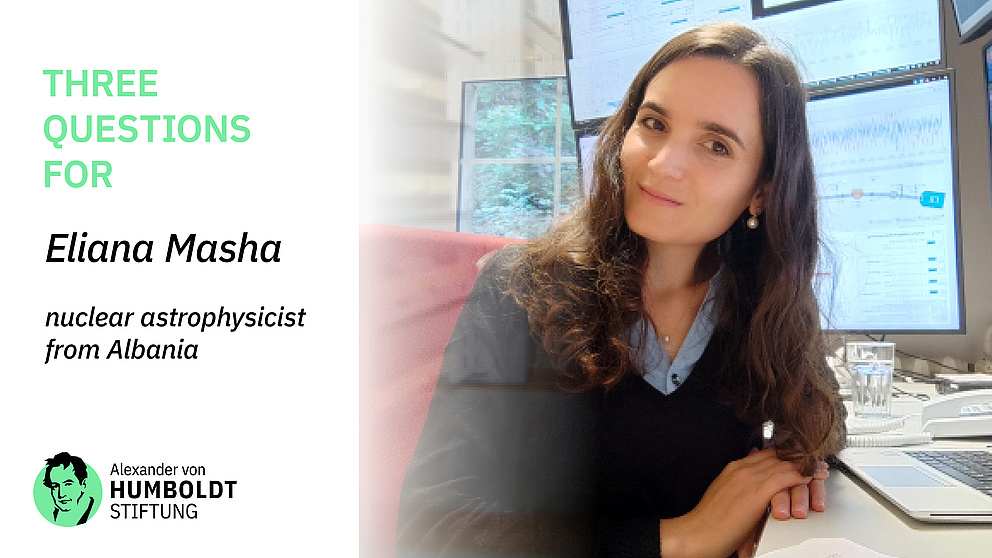
Contact
Press, Communications and Marketing
Tel.: +49 228 833-144
Fax: +49 228 833-441
presse[at]avh.de
Nuclear astrophysicist Eliana Masha can see the sun best from underground. Forty-five metres below the Earth’s surface, the Humboldt Research Fellow and guest researcher from the University of Milan is conducting research in the Felsenkeller underground laboratory of the Helmholtz-Zentrum Dresden-Rossendorf and the Technical University Dresden to find out what is happening in the sun and other stars. “This could one day give us insights into how the universe came into being”, explains Eliana Masha. Today, in the space that the Felsenkeller brewery in Dresden once used to store ice stands an eight-metre long, 10-tonne particle accelerator which Eliana Masha and her host Professor Daniel Bemmerer are using to conduct astrophysical experiments to replicate nuclear reactions in the interior of the sun. “We fire charged atomic particles with five million volts at other atoms and make them collide in the hope that two nuclei fuse to create a new element. The massive stone ‘roof’ overhead shields the space from cosmic radiation. Accurate measurements would otherwise not be possible.”
It all – including Eliana Masha’s passion for science – began with the sun. “I remember a class at school where our teacher said, “The sun is a star like all the other stars, it’s just the closest star to the Earth.” I then asked, “What’s a star?” And he explained.” Masha grew up in Luz i Madh, a suburb of the city Kavajë, located in the Western Lowlands region of Albania “When you look at the night sky there, you can see the Milky Way. Ever since that day at school, I’ve looked at it with different eyes. More and more questions kept popping up for me and I began to read books about stars.” Even while still at school she regularly took part in science competitions. A physics teacher at her school noticed and fostered her talent. Despite this, it never occurred to Masha that she might one day study physics and become a nuclear astrophysicist.
Lucky coincidence
“It was a different world in Albania 18 years ago. Young women usually got married after finishing school. But I wanted to go to university. Initially, I didn’t say anything about this to my parents. But at some point, they understood that I was genuinely interested in science. Eventually, with a great deal of sacrifice on their part, they sent me to the best private secondary school in town.
This wasn’t easy for my mother. She probably would have found it better if I had had a ‘normal life’,” notes Masha. Despite her enthusiasm for physics, she initially decided to study medicine in Milan. A field that – back then – seemed to be ‘more suitable’ for women. She has a coincidence to thank for the fact that she nonetheless landed in her field. “I missed the deadline for registering for medicine so I studied biology for a short time until I switched to physics and then landed in astrophysics.” Masha was diving in deep even during her bachelor studies. She was involved in experiments at LUNA in Gran Sasso, the world’s largest underground laboratory, followed this up with an internship in the Felsenkeller lab in Dresden in 2016, and then decided to go into research.
An occupation for everyone
Eight years later she came back with a doctorate in nuclear astrophysics in her pocket. “Right now I’m the only woman here. My team is great and I don’t notice any differences. But what does strike me is that in contrast to Italy, I see only a few women in my field here in Germany. I really wish that steps would be taken to make working in science easier for people with children or who are caretakers and that more of them would take up leadership positions. I have high hopes that we will see great progress in this regard at the new Deutsches Zentrum für Astrophysik in Görlitz.” And something else is close to her heart. “I try to get the message across to children, teenagers and my students that being a researcher is a normal occupation that anyone can go into. You don’t have to be a genius.
But what you do need, according to Masha, is to always have more questions than answers, be excited about what you do, and be daring. When she applied for a Humboldt Fellowship, she actually expected to be turned down. “Everyone was saying how difficult it is to receive a fellowship. So I was even happier to be accepted. This fellowship will advance not only my career but also my personal development. From now on I will benefit from this fellowship time and again.” One of her professors who herself was a Humboldt Fellow 20 years ago always said that the Humboldt network is like a family. “I couldn’t imagine what this would be like until I experienced the meeting to welcome new fellows. There was a definite sense that the focus was not only on my research but on me as a person as well. That was a good feeling.” Eliana Masha experiences this in her research group too. “We’re a great team. When I think about the Felsenkeller lab, it doesn’t feel like a workplace, but more like a home. That makes me happy.”
Author: Esther Sambale




